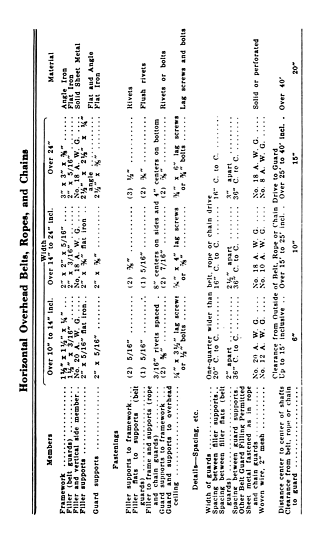§ 29.135. Materials and construction of guards.
(a) Wood shall be sound, tough and free from any loose knots.
(b) Guards shall be made of planed lumber not less than 1 inch rough board measure and edges and corners rounded off.
(c) Wood guards shall be securely fastened together with wood screws, hard wood dowel pins, bolts or rivets.
(d) While no definite dimensions are given under this heading for framework or filler materials, wood guards shall be equal in strength and rigidity to metal guards specified in § 29.134(d) and (e) (relating to construction of guards).
(e) Construction of standard wood railings shall be according to the requirements of § 29.134(g).
(f) Machinery required to be guarded in the slate industry shall be equipped with guards of slate construction at least one inch in thickness except where the installation of the guards prevents proper light from being shed on any operation.
(g) Guards for horizontal overhead belts, ropes and chains shall be according to the following specifications:
(1) Guards for horizontal overhead belts, ropes and chains shall run the entire length of the belt, rope or chains and follow the line of the pulleys or sprockets to the ceiling or be carried to the nearest wall, thus enclosing the belt, rope or chain effectively. When belts, ropes or chains are so located as to make it impracticable to carry the guard to the wall or ceiling, construction of the guard shall be such as to enclose completely the top and bottom runs of the belt, rope or chain and the face of pulleys or sprockets.
(2) The guard and all its supporting members shall be securely fastened to the wall or ceiling by gimlet-point lag screws or through bolts. In case of masonry construction, expansion bolts shall be used. The use of bolts placed horizontally through floor beams or ceiling rafters is recommended.
(3) Suitable reinforcements shall be provided for the ceiling rafters or overhead floor beams when such is necessary, to sustain safely the weight and stress likely to be imposed by the guard. The interior surface of all guards, by which is meant the surface of the guard with which a belt, rope, or chain comes in contact, shall be smooth and free from all projections of any character, except when construction demands it; protruding shallow roundhead rivets may be used. Overhead belt guards shall be at least 1/4 wider than the belt which they protect, except that this clearance need not in any case exceed 6 inches on each side. Overhead rope drive and block and roller-chain-drive guards shall be not less than 6 inches wider than the drive on each side. In overhead silent chain-drive guards where the chain is held from lateral displacement on the sprockets, the side clearance required on drives of 20 inch centers or under shall be not less than 1/4 inch from the nearest moving chain part and on drives of over 20 inch centers a minimum of 1/2 inch from the nearest moving chain part.
(4) In overhead rope or chain guards a side guard member of the same solid filling material shall be carried up in a vertical position 2 inches above the level of the lower run of the rope or chain drive and 2 inches within the periphery of the pulleys which the guard encloses thus forming a trough. These side filler members shall be reinforced on the edges with 1-1/2 inch by 1/4 inch flat steel, riveted to the filling material at not greater than 8 inch centers; the reinforcing strip shall be fastened or bolted to all guard-supporting members with at least one 3/8 inch rivet or bolt at each intersection, and the ends shall be secured to the ceiling with lag screws or bolts.
(h) A disc guard shall consist of a sheet metal disc not less than No. 22 gauge fastened by U-bolts or rivets to spokes of pulleys, flywheels, or gears. When possibility of contact with sharp edges of the disc exists, the edge shall be rolled or wired. In all cases the nuts shall be provided with lock nuts which shall be placed on the unexposed side of the wheel.
(i) U-guards shall be constructed of materials specified in § 29.134 (e). Edges shall be smooth and if the size of the guard requires, these edges shall be reinforced by rolling, wiring, or by binding with angle or flat iron.
(j) The following table gives sizes of materials to be used and general construction of guards for belts ten inches or more in width. No material for overhead belt guards shall be smaller than that specified in this table for belts ten inches wide, even if the belt is less than ten inches in width. However, No. 20 gauge sheet metal may be used as a filler on guards for belts less than ten inches wide. Expanded metal, because of the sharp edges, should not be used as a filler in horizontal belt guards:

No part of the information on this site may be reproduced for profit or sold for profit.
This material has been drawn directly from the official Pennsylvania Code full text database. Due to the limitations of HTML or differences in display capabilities of different browsers, this version may differ slightly from the official printed version.